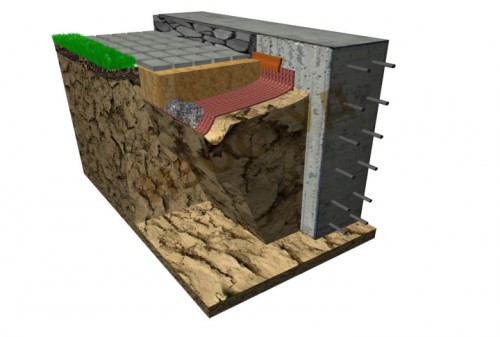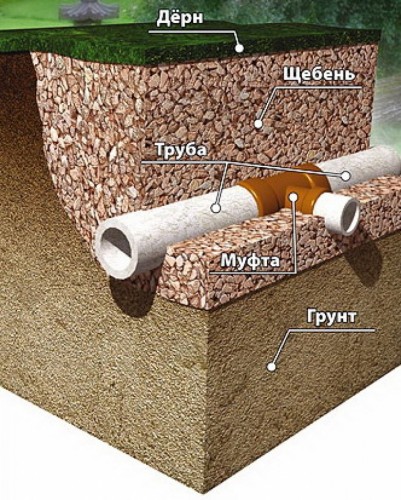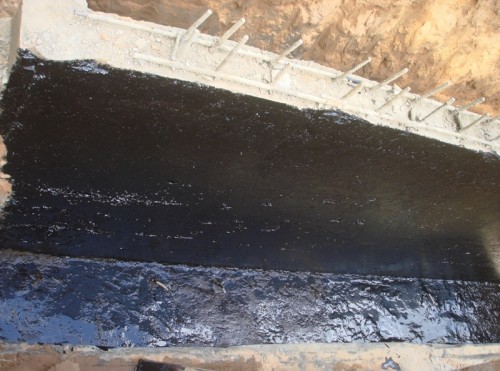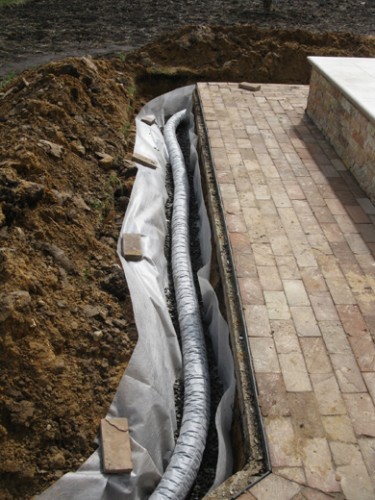
How to Protect Foundation from Water Construction

Water is not always a "friend" of a person. Sometimes it brings terrible destruction in the form of showers and tsunami. Often, no one notices her activities in the form of small rains, fogs, dews or Inea. However, its monotonous impact on the structure of a person, water gradually displays them. That this does not happen to be able to protect your home from moisture. The foundation should be waterproof first.
Content
- Total Protection of Fundament
- (adsbygoogle \u003d window.adsbygoogle || []). Push (()); yandex_partner_id \u003d 53889; yandex_site_bg_color \u003d 'fffff'; yandex_ad_format \u003d 'direct'; yandex_font_size \u003d 1.0; yandex_direct_type \u003d 'vertical'; yandex_direct_border_type \u003d 'ad'; yandex_direct_limit \u003d 1; yandex_direct_title_font_size \u003d 2; yandex_direct_links_underline \u003d true; yandex_direct_bg_color \u003d 'fffff'; yandex_direct_border_color \u003d 'fffff'; yandex_direct_title_color \u003d '0C77EC'; yandex_direct_url_color \u003d '000000'; yandex_direct_text_color \u003d '000000'; yandex_direct_hover_color \u003d 'CC0000'; yandex_direct_favicon \u003d true; yandex_no_sitelinks \u003d true; document.write (''); Protection of the foundation from groundwater
- Isolation in the building without basement
- yandex_partner_id \u003d 53889; yandex_site_bg_color \u003d 'fffff'; yandex_ad_format \u003d 'direct'; yandex_font_size \u003d 1.0; yandex_direct_type \u003d 'vertical'; yandex_direct_border_type \u003d 'ad'; yandex_direct_limit \u003d 1; yandex_direct_title_font_size \u003d 2; yandex_direct_links_underline \u003d true; yandex_direct_bg_color \u003d 'fffff'; yandex_direct_border_color \u003d 'fffff'; yandex_direct_title_color \u003d '0C77EC'; yandex_direct_url_color \u003d '000000'; yandex_direct_text_color \u003d '000000'; yandex_direct_hover_color \u003d 'CC0000'; yandex_direct_favicon \u003d true; yandex_no_sitelinks \u003d true; document.write (''); (adsbygoogle \u003d window.adsbygoogle || []). Push (()); Protection of the foundation from moisture in a building with a basement
- Foundation Protection
- Rain Foundation Protection
Total Protection of Fundament
Content
- Total Protection of Fundament
- (adsbygoogle \u003d window.adsbygoogle || []). Push (()); yandex_partner_id \u003d 53889; yandex_site_bg_color \u003d 'fffff'; yandex_ad_format \u003d 'direct'; yandex_font_size \u003d 1.0; yandex_direct_type \u003d 'vertical'; yandex_direct_border_type \u003d 'ad'; yandex_direct_limit \u003d 1; yandex_direct_title_font_size \u003d 2; yandex_direct_links_underline \u003d true; yandex_direct_bg_color \u003d 'fffff'; yandex_direct_border_color \u003d 'fffff'; yandex_direct_title_color \u003d '0C77EC'; yandex_direct_url_color \u003d '000000'; yandex_direct_text_color \u003d '000000'; yandex_direct_hover_color \u003d 'CC0000'; yandex_direct_favicon \u003d true; yandex_no_sitelinks \u003d true; document.write (''); Protection of the foundation from groundwater
- Isolation in the building without basement
- yandex_partner_id \u003d 53889; yandex_site_bg_color \u003d 'fffff'; yandex_ad_format \u003d 'direct'; yandex_font_size \u003d 1.0; yandex_direct_type \u003d 'vertical'; yandex_direct_border_type \u003d 'ad'; yandex_direct_limit \u003d 1; yandex_direct_title_font_size \u003d 2; yandex_direct_links_underline \u003d true; yandex_direct_bg_color \u003d 'fffff'; yandex_direct_border_color \u003d 'fffff'; yandex_direct_title_color \u003d '0C77EC'; yandex_direct_url_color \u003d '000000'; yandex_direct_text_color \u003d '000000'; yandex_direct_hover_color \u003d 'CC0000'; yandex_direct_favicon \u003d true; yandex_no_sitelinks \u003d true; document.write (''); (adsbygoogle \u003d window.adsbygoogle || []). Push (()); Protection of the foundation from moisture in a building with a basement
- Foundation Protection
- Rain Foundation Protection
Water can act on the foundation of the house in different ways. If we talk about the heavenly moisture, it can gradually disinite any materials from which the foundation of the house is made. This happens according to the simple formula, which is known to us from the childhood from the proverb: "Water stone sharpens." The second type of moisture that affects the foundation can be observed and felt in the soil or other substrate, which will be completed after the completion of construction work. Contact the foundation. Well, the third type - the water is ground, which is most often not visible, but her destructive power is colossal. From groundwater, the foundation suffers mainly in the spring. Therefore, the owner of the house, who wants its structure to light up the maximum number of years, must completely protect the foundation from all three water impacts on it.

Protection of the foundation from groundwater
The most important thing when protecting the foundation of the house, if you are his direct builder - to carry out all the work at once, in the process of laying the foundation. Protective measures are planned with such a calculation so that water, climbing even above the critical mark by 50-60 cm, could not destroy the foundation. For this, the building around the building around is surrounded by a breakdown or sidewalk.
If the building is built without basement, and the groundwater takes deeply, it will be enough to build a simple waterproofing from capillary moisture. Then the moisture from the soil millet will not be able to rise up to the foundation.

If we talk about the drainage system, it is suitable when the intended and valid level of groundwater, it will be higher than the floor level in the basement of the house. The purpose of this is to prevent the raising of groundwater. Drainage is simply arranged, especially if there are collectors or reservoirs nearby, which can be easily removed all the water from the building. But it happens so that making drainage is not possible, let's say, due to the features of the relief. Then they protect the house from the water by arranging a special waterproofing. Protecting the foundation from water with waterproofing can be different.
Isolation in the building without basement
When the building does not have basement, the insulation of the water is paired directly in the basement. They make it 1-1.5 cm below all the floors of the floor and about 2 cm above the sidewalks above the ground. From soil moisture, the building is protected by concrete training of gender, which, together with a layer of isolation, must necessarily be related to each other. If the preparation of the floor is located below than the insulation layer, then the bitumen layer is used as a binder material (preferably dual), applied from the inside to the surface of the base.
The insulating layer has such variations: 1.2 cm asphalt thick. You can apply a layer of cement mortar in a mixture with hydrosite or cerezite. Such a solution is prepared according to the formula 1 to 1.5 and is stacked with a layer of 1.5 cm with a layer of 1.5 cm. More, the rubberoid is often used for the same purposes, laying it into two layers. Both layers are missing between themselves bitumen mass.
If the base has a height of more than 60 cm, then two layers of insulation are laid. The first layer is placed on 10-15 cm below all the structures of the floor, and the second layer is laid by 20 cm above the sidewalk. In addition, the entire inner surface of the wall, which comes into contact with the soil, is riveted with a split bitumen in 2 layers directly between isolation and concrete preparation.

Protection of the foundation from moisture in a building with a basement
If there is a basement, waterproofing from capillary moisture is arranged at the floor level of the basement, as well as above the surface of the sidewalk by 20 cm. The walls of the basement are protected from damp, using double coating with hot bitumen along the dried plaster.
If the building often experiences soil water pressure - it is better to simply arrange drainage, but if it is impossible to implement, it will come up and the continuous shell is impenetrable for water from the outside of the basement.
Foundation Protection
First you need to deal with the concept of "soil beaming". This phrase is used in describing those soils that have a lot of moisture in their composition, and therefore, with the occurrence of severe frosts, it may increase in volume and rise, according to the simplest physical laws.
When erecting houses on such bubbly soils, under the base of the foundation, a pillow of gravel, special washed sand or gravel and rubbed plugs are arranged. The base created from these non-bunching materials prevents the impact on the lower part of the foundation of the pushing forces of frosty powder. It is important to remember that with a significant increase in the water level in the ground, it can be in the autumn period or during the melting of snow, water is accumulated around the submetroce, saturated with particles of not necessary dust-clay soil. Having moved along with water, the soil particles penetrate directly into the subtype and they clog it, slowly turning the normal soil into the pumped.
For several years of operation of the foundation, it turns out to be on the ground, which is deformed during freezing. Preventing the adhesion of the submetakes, you can use special filter materials such as glass cholester or tappea. They skip water well, however, prevent the penetration of the smallest dust-clay particles.
One of the ways to reduce the activity of the soils of the bunched type is the organization of drainage. It allows you to lower the humidity of the soil due to a decrease in the water level in the soil. The traditional design of the drainage system is several drainage pipes, which are placed in a layer of washing gravel, delaying large particles of soil. Pipes are put with a slight bias, ensuring in turn the flow of water into the well or simply sewer.
A filtering material that does not miss even the smallest particles around the drainage pipes and therefore ensures the effective operation of the entire drainage system without labor-intensive cleaning. Protection of the foundation from the freezing is carried out in the same way as in the prevention of exposure to the bunched soil.
Rain Foundation Protection

Most often, for these purposes, primers are used in different brands, which create a solid protective film that prevents the penetration of moisture from the air on the foundation. It is best to apply primer into several layers with a preliminary drying of each. The optimal option will be an annual impregnation of the outer part of the basement of the primer.
In addition, it is necessary to protect the waterproofing of the foundation from mechanical damage. This is achieved by tracking so that there is no strong load on the waterproofing, and it has not been exposed to strain.
Some people are disturbing the question of those actions that are taking at the flow of water under the base in the spring time, if they did not immediately make waterproofing. In this case, you need to take water from home by any ways, especially when it is a lot. This is done by pulling out drainage channels and drainage systems. If the water fell into the basement, then after eliminating its further, the flow of wet places are dried by electrocalores and other similar devices.



















